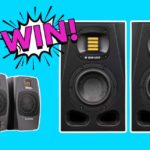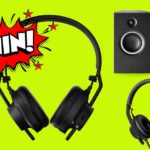
Review: 5 Top Computer Speakers for DJing
Digital DJing allows people whose circumstances mean they could not have a full DJ set-up to still enjoy DJing at home. With a small DJ controller and a laptop or desktop PC, all you need is a flat surface to set up on and you’re off. Great if you’re in college, a small apartment, a hotel room, your bedroom, a rented studio…
One thing you’ll need, however, are speakers. DJing needs decent external sound as well as headphone monitoring. But while cheap computer speakers won’t cut it, many people simply don’t have the room or budget for dedicated studio monitors. So in this review, we look at 5 pairs of high-end desktop computer speakers that can also be used as home DJ speakers.
Speakers for DJing
You’ll probably end up doing your DJ practice at home through one of these speaker types:
- Cheap computer speakers – You may already have some of these, but you’ll want to upgrade – fast. You need volume to DJ with, at least to a certain point, and you need good quality sound to get “lost in the groove”. Cheap speakers can get you to first base but they’re not going to cut it in the long run
- Hi-fi speakers – Depending on the quality of your home hi-fi (or cinema system), you could just plug into your home speakers via a spare input. This can be a sensible solution if you are DJing in the same room this system is set up in, but is not much good if you have a computer desk or DJ area in another room
- 2.1 computer speakers– These are computer speaker systems where there are 2 small satellite speakers and a separate bass “sub-woofer” (hence 2.1). Some can be pretty good, but most are like the cheap computer speakers above, with bass added – they sound is very coloured, far from realistic and of course are not very portable (or space-saving). Still, worth considering as an all-round system if you have the space and can afford decent ones. At least you’ll get the bass “thud” for electronic music, which is better than nothing
- Studio/DJ monitors – Either active or passive (ie needing a separate amplifier), if you have the money, the room and a lack of neighbours, a pair of decent active studio monitors dedicated to your DJ set-up will give you the best sound of all
- High-end 2.0 computer speakers – A step up from cheap computer speakers, these have better build and louder amplification, and typically come with extra features for maximum flexibility. While there are necessary compromises, if you’re short on space and/or cash but still want a decent DJ system, these can make it possible for you. They’re easy to set up, with one speaker being powered from the other.
It’s the final ones – the high-end 2.0 computer speakers – that we’re covering in this review.
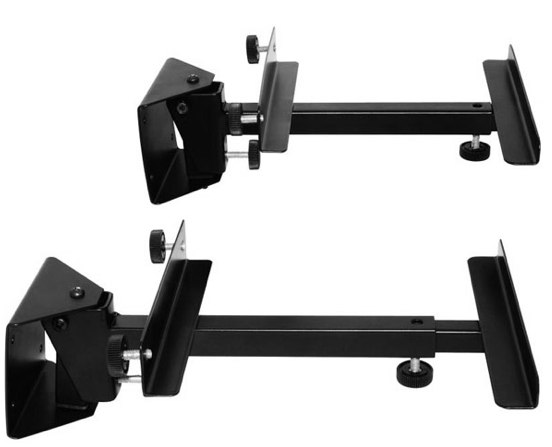
Choosing 2.0 desktop speakers
We’ve only chosen decent quality speakers here. We’ve looked for flexibility (multiple inputs is good), enough volume to fill a small room, and the difficult compromise between bass (you’re not going to get much, but it’s made up for by high fidelity) and “footprint” (too big and you’ll just have no room for them in a portable set-up).
We narrowed it down to 5 pairs that we feel we can recommend to you. While none is good enough for music production or studio use, all have enough star quality to work in a compact digital DJ set-up. All are magnetically shielded so they’ll work well next to computer monitors (and your mobile phone). Here’s some things to bear in mind:
- Your choice will depend on the amount of desk space you have, the size of the room (less power is OK for smaller rooms), the number of inputs you need, how important things like bass and treble controls are to you, and of course the cost
- One thing to bear in mind is that for speakers to sound at their best, they need to be pointing at your head – consider shelving, mounts or angling the speakers as some of these designs would otherwise point at your hand, and hands don’t have ears
- If you think you may eventually want to add some extra bass, look for models that allow you to add a sub-woofer later on (only the Cakewalk model below has this provision)
- Look at where you’re going to plug your DJ kit in – some have 3.5mm sockets at the front, some are round the back, others have RCAs, some only have one input so you’ll constantly be unplugging them from your computer if you use them as PC speakers too
As usual, we’ve only included products we’ve got first-hand experience of. but we urge you to do your own research before buying, and remind you that inclusion in this review does not imply suitability to your particular circumstances.
Try and see them “for real”, or alternatively get them from a retailer with a return policy in case you decide they’re not for you.
The speakers

Audioengine 2 (A2)
Price: US$199 / £142
Rating: [rating=5]
Power: 30W RMS; Controls: On/off, volume; Inputs: Dual 3.5mm and RCA jacks; Outputs: none; Size: 6 x 4 x 5.25″ (152 x 102 x 143mm); Total weight: 6.7lb (3kg)
They say: The A2 was designed for your desktop but is also perfect for smaller rooms. Well-suited for all types of music, movies, and videogames, the A2 sounds great with or without a subwoofer. To say that the bass on the Audioengine 2 is substantial for their size may be an understatement, but you should be the judge.
We say: Scaled down from their respected A5 speakers, these offer great components, fantastic build quality and excellent sound. They are the most expensive speakers in our test, but their size to sound ratio is impressive. No frills or extras – all the money has gone into the sound components. Will suit minimalists, with their uncluttered fascias.

Cakewalk MA-15D
Price: US$179 / £158
Rating: [rating=5]
Power: 30W RMS; Controls: On/off, volume, bass, treble, bass boost, volume (line 1/digital), volume (line 2), digital input select; Inputs: RCA, 3.5mm, digital (optical/coaxial); Outputs: 6.3mm phones, RCA subwoofer; Size: active 6.3 x 8.8 x 9.8″ (159 x 222 x 250mm), passive 6.3 x 8.6 x 9.8″ (159 x 215 x 250mm); Total weight: 16.8lb (7.5kg)
They say: The MA-15D Digital Stereo Monitors are ideal for a number of professional and consumer uses. They are great options as studio reference monitors. The MA-15D’s offer a wide-range spectrum and crystal-clear audio reproduction. They feature a built-in Bass Enhancer, which operates on psycho acoustic principles that converts low frequencies into a series of overtones the human ear cannot distinguish from the original low frequencies.
We say: Best equipped speakers in the test, including a 24-bit/up to 192kHz digital-to-analogue converter for the digital input. Well made, flexible (effectively there’s a 2-channel mixer built-in). They are pretty deep so make sure you’ve got enough desk space to accommodate them. Would have been nice to have the 3.5mm input on the front for easy access. (Also known as Edirol MA-15D.)

Creative GigaWorks T40 Series II
Price: US$113 / £77
Rating: [rating=3]
Power: 32 watts RMS; Controls: On/off, volume, bass, treble; Inputs: 3.5mm; Outputs: 3.5mm phones; Size: 3.5 x 5.5 x 12.3″ (89 x 140 x 312mm); Total weight: 3.3lb (1.5kg)
They say: GigaWorks T40 Series II propels audio enjoyment into the next level of acoustic fidelity. The 3-Driver audiophile configuration, with BasXPort™ technology delivers excellent dynamics with rich extended bass, eliminating the need for a subwoofer. The silk dome tweeter with dual woven glass fibre drivers produces crystal clear highs with full range audio.
We say: Lots to like at this price point. We like the bass and treble at the front (good for getting the best from Beatport previews and the like), and the angle means they’d sound good when you’re dancing round the room. Not the best in sound quality out of the pack, but they are the cheapest. Big, but with a small footprint. Would have liked more inputs. Great computer speakers, but for DJing? Just about OK.
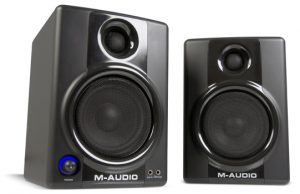
M-Audio Studiophile AV 40
Price: US$169 / £112
Rating: [rating=5]
Power: 40W RMS; Controls: On/off, volume, bass boost; Inputs: RCA line, 3.5mm, 1/4″ TRS; Outputs: 3.5mm phones; Size: 8.8 x 6 x 7.3″ (240 x 152 x 185mm); Total weight: 14lb (6.3kg)
They say: Deliver the same proven M-Audio technology favoured by top producers, recording engineers and musicians around the world. Custom cabinets with dense wood construction deliver more accurate bass response than you could ever get from plastic multimedia speakers. The perfect solution for travelling musicians or anyone who wants top-notch sound from their desktop multimedia system.
We say: Heavy, rather large, ported speakers. They look great and sound amazing, borrowing much of their technology from M-Audio’s acclaimed studio monitor speakers. Widest range of inputs of any of the speakers in the test which are mixed, so you can plug all sorts in and keep it plugged in. Good if you’ve got room on your desktop and value for money too.
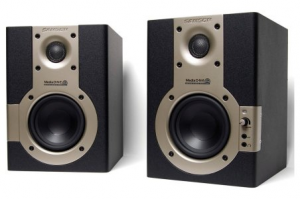
Samson MediaOne 4a
Price: US$149 / £103
Rating: [rating=4]
Power: 40W RMS; Controls: On/off, volume; Inputs: RCA line, 3.5mm; Outputs: 3.5mm phones; Size: active 6.6 x 9 x 9.1″ (168 x 229 x 232mm), passive 6.6 x 7.6 x 9.1″ (168 x 194 x 232mm); Total weight: 16lb (7.3kg)
They say: The MediaOne 4a active monitors are an ideal near-field monitor system for studios, video post-production suites, fixed installations or anywhere else great sound is desired. Thanks to top-notch components and innovative design, the versatility of these monitors guarantees professional audio and reliable performance in any application.
We say: Very good clarity in the mids and tops, from a company better known for providing higher priced monitors. Equally bulky and even heavier than the M-Audio AV40s, but that’s because they’re bordering on studio monitor territory – and it shows in the sound quality. Lacking a bit of bass, and no “bass boost” option like the AV 40s, but good value and great sound nonetheless.
Conclusion
If you’re after just one pair of speakers in your life – speakers that can handle movies, gaming, DJing, day-to-day computer use and so on – and you need those speakers to be portable, offer great sound and live happily on the same small desk or surface as your laptop and DJ controller, then a set of high-end 2.0 computer speakers may well fit the bill.
As you’ve seen, many of these speakers offer extras that you don’t get on dedicated studio monitors that may make your life considerably easier. As long as the room you want them to fill is not too big, and you choose carefully, you could get the best of all worlds. You’ll never have earth-shattering bass, but you can have clarity of sound and enough volume for you to get lost in your mixing – which is the main thing, after all.
Do you have a tiny DJ set-up? What do you use as monitor speakers? What would you use if you could? Do you have any other unusual speakers that you’d recommend for those with space, volume or cash constraints? Let us know in the comments!





